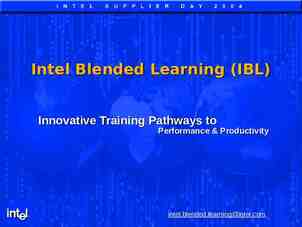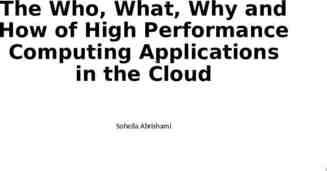Memory Management: Virtual Memory and Paging CS 111 Operating Systems
59 Slides1.17 MB

Memory Management: Virtual Memory and Paging CS 111 Operating Systems Peter Reiher CS 111 Fall 2015 Lecture 11 Page 1

Outline Paging Swapping and demand paging Virtual memory CS 111 Fall 2015 Lecture 11 Page 2

Paging What is paging? – What problem does it solve? – How does it do so? Paged address translation Paging and fragmentation Paging memory management units CS 111 Fall 2015 Lecture 11 Page 3

Segmentation Revisited Segment relocation solved the relocation problem for us It used base registers to compute a physical address from a virtual address – Allowing us to move data around in physical memory – By only updating the base register It did nothing about external fragmentation – Because segments are still required to be contiguous We need to eliminate the “contiguity requirement” CS 111 Fall 2015 Lecture 11 Page 4

The Paging Approach Divide physical memory into units of a single fixed size – A pretty small one, like 1-4K bytes or words – Typically called a page frame Treat the virtual address space in the same way For each virtual address space page, store its data in one physical address page frame Use some magic per-page translation mechanism to convert virtual to physical pages CS 111 Fall 2015 Lecture 11 Page 5

Paged Address Translation process virtual address space CODE CS 111 Fall 2015 DATA physical memory STACK Lecture 11 Page 6

Paging and Fragmentation A segment is implemented as a set of virtual pages Internal fragmentation Averages only ½ page (half of the last one) External fragmentation Completely non-existent We never carve up pages CS 111 Fall 2015 Lecture 11 Page 7

How Does This Compare To Segment Fragmentation? Consider this scenario: – Average requested allocation is 128K – 256K fixed size segments available – In the paging system, 4K pages For segmentation, average internal fragmentation is 50% (128K of 256K used) For paging? – Only the last page of an allocation is not full – On average, half of it is unused, or 2K – So 2K of 128K is wasted, or around 1.5% Segmentation: 50% waste CS 111 Fall 2015 Paging: 1.5% waste Lecture 11 Page 8

Providing the Magic Translation Mechanism On per page basis, we need to change a virtual address to a physical address Needs to be fast – So we’ll use hardware The Memory Management Unit (MMU) – A piece of hardware designed to perform the magic quickly CS 111 Fall 2015 Lecture 11 Page 9

Paging and MMUs Virtual address page # Virtual page number is used as an index into the page table Valid bit is checked to ensure that this virtual page number is CS 111 Fall 2015 legal Physical address offset V V V 0 V 0 V V page # page # page # page # page # page # page # Page Table offset Offset within page remains the same Selected entry contains physical page number Lecture 11 Page 10

Some Examples Virtual address 0004 0000 0005 1C08 3E28 0100 V V V 0 V 0 V V CS 111 Fall 2015 Physical address 0C20 041F 0C20 0105 00A1 1C08 0100 Hmm, no address Why might that happen? And what can we do about it? 041F 0D10 0AC3 Page Table Lecture 11 Page 11

The MMU Hardware MMUs used to sit between the CPU and bus – Now they are typically integrated into the CPU What about the page tables? – Originally implemented in special fast registers – But there’s a problem with that today – If we have 4K pages, and a 64 Gbyte memory, how many pages are there? – 236/212 224 – Or 16 M of pages – We can’t afford 16 M of fast registers CS 111 Fall 2015 Lecture 11 Page 12

Handling Big Page Tables 16 M entries in a page table means we can’t use registers So now they are stored in normal memory But we can’t afford 2 bus cycles for each memory access – One to look up the page table entry – One to get the actual data So we have a very fast set of MMU registers used as a cache – Which means we need to worry about hit ratios, cache invalidation, and other nasty issues – TANSTAAFL CS 111 Fall 2015 Lecture 11 Page 13

The MMU and Multiple Processes There are several processes running Each needs a set of pages We can put any page anywhere But if they need, in total, more pages than we’ve physically got, Something’s got to go How do we handle these ongoing paging requirements? CS 111 Fall 2015 Lecture 11 Page 14

Ongoing MMU Operations What if the current process adds or removes pages? – Directly update active page table in memory – Privileged instruction to flush (stale) cached entries What if we switch from one process to another? – Maintain separate page tables for each process – Privileged instruction loads pointer to new page table – A reload instruction flushes previously cached entries How to share pages between multiple processes? – Make each page table point to same physical page – Can be read-only or read/write sharing CS 111 Fall 2015 Lecture 11 Page 15

Swapping Segmented paging allows us to have (physically) non-contiguous allocations – Virtual addresses in one segment still contiguous But it still limits us to the size of physical RAM How can we avoid that? By keeping some segments somewhere else Where? Maybe on a disk CS 111 Fall 2015 Lecture 11 Page 16

Swapping Segments To Disk An obvious strategy to increase effective memory size When a process yields, copy its segments to disk When it is scheduled, copy them back Paged segments mean we need not put any of this data in the same place as before yielding Each process could see a memory space as big as the total amount of RAM CS 111 Fall 2015 Lecture 11 Page 17

Downsides To Segment Swapping If we actually move everything out, the costs of a context switch are very high – Copy all of RAM out to disk – And then copy other stuff from disk to RAM – Before the newly scheduled process can do anything We’re still limiting processes to the amount of RAM we actually have – Even overlays could do better than that CS 111 Fall 2015 Lecture 11 Page 18

Demand Paging What is paging? – What problem does it solve? – How does it do so? Locality of reference Page faults and performance issues CS 111 Fall 2015 Lecture 11 Page 19

What Is Demand Paging? A process doesn’t actually need all its pages in memory to run It only needs those it actually references So, why bother loading up all the pages when a process is scheduled to run? And, perhaps, why get rid of all of a process’ pages when it yields? Move pages onto and off of disk “on demand” CS 111 Fall 2015 Lecture 11 Page 20

How To Make Demand Paging Work The MMU must support “not present” pages – Generates a fault/trap when they are referenced – OS can bring in page and retry the faulted reference Entire process needn’t be in memory to start running – Start each process with a subset of its pages – Load additional pages as program demands them The big challenge will be performance CS 111 Fall 2015 Lecture 11 Page 21

Achieving Good Performance for Demand Paging Demand paging will perform poorly if most memory references require disk access – Worse than bringing in all the pages at once, maybe So we need to be sure most don’t How? By ensuring that the page holding the next memory reference is already there – Almost always CS 111 Fall 2015 Lecture 11 Page 22

Demand Paging and Locality of Reference How can we predict what pages we need in memory? – Since they’d better be there when we ask Primarily, rely on locality of reference – Put simply, the next address you ask for is likely to be close to the last address you asked for Do programs typically display locality of reference? Fortunately, yes! CS 111 Fall 2015 Lecture 11 Page 23

Reasons Why Locality of Reference Works For program instructions? For stack access? For data access? CS 111 Fall 2015 Lecture 11 Page 24

Instruction Locality of Reference Code usually executes sequences of consecutive instructions Most branches tend to be relatively short distances (into code in the same routine) Even routine calls tend to come in clusters – E.g., we’ll do a bunch of file I/O, then we’ll do a bunch of list operations CS 111 Fall 2015 Lecture 11 Page 25

Stack Locality of Reference Obvious locality here We typically need access to things in the current stack frame – Either the most recently created one – Or one we just returned to from another call Since the frames usually aren’t huge, obvious locality here CS 111 Fall 2015 Lecture 11 Page 26

Heap Data Locality of Reference Many data references to recently allocated buffers or structures – E.g., creating or processing a message Also common to do a great deal of processing using one data structure – Before using another But more chances for non-local behavior than with code or the stack CS 111 Fall 2015 Lecture 11 Page 27

Page Faults Page tables no longer necessarily contain points to pages of RAM In some cases, the pages are not in RAM, at the moment – They’re out on disk When a program requests an address from such a page, what do we do? Generate a page fault – Which is intended to tell the system to go get it CS 111 Fall 2015 Lecture 11 Page 28

Handling a Page Fault Initialize page table entries to “not present” CPU faults if “not present” page is referenced – Fault enters kernel, just like any other trap – Forwarded to page fault handler – Determine which page is required, where it resides – Schedule I/O to fetch it, then block the process – Make page table point at newly read-in page – Back up user-mode PC to retry failed instruction – Return to user-mode and try again Meanwhile, other processes can run CS 111 Fall 2015 Lecture 11 Page 29

Pages and Secondary Storage When not in memory, pages live on secondary storage – Typically a disk – In an area called “swap space” How do we manage swap space? – As a pool of variable length partitions? Allocate a contiguous region for each process – As a random collection of pages? Just use a bit-map to keep track of which are free – As a file system? Create a file per process (or segment) File offsets correspond to virtual address offsets CS 111 Fall 2015 Lecture 11 Page 30

Demand Paging Performance Page faults may result in shorter time slices – Standard overhead/response-time tradeoff Overhead (fault handling, paging in and out) – Process is blocked while we are reading in pages – Delaying execution and consuming cycles – Directly proportional to the number of page faults Key is having the “right” pages in memory – Right pages - few faults, little paging activity – Wrong pages - many faults, much paging We can’t control what pages we read in – Key to performance is choosing which to kick out CS 111 Fall 2015 Lecture 11 Page 31

Virtual Memory A generalization of what demand paging allows A form of memory where the system provides a useful abstraction – A very large quantity of memory – For each process – All directly accessible via normal addressing – At a speed approaching that of actual RAM The state of the art in modern memory abstractions CS 111 Fall 2015 Lecture 11 Page 32

The Basic Concept Give each process an address space of immense size – Perhaps as big as your hardware’s word size allows Allow processes to request segments within that space Use dynamic paging and swapping to support the abstraction The key issue is how to create the abstraction when you don’t have that much real memory CS 111 Fall 2015 Lecture 11 Page 33

The Key VM Technology: Replacement Algorithms The goal is to have each page already in memory when a process accesses it We can’t know ahead of time what pages will be accessed We rely on locality of access – In particular, to determine what pages to move out of memory and onto disk If we make wise choices, the pages we need in memory will still be there CS 111 Fall 2015 Lecture 11 Page 34

The Basics of Page Replacement We keep some set of all possible pages in memory – Perhaps not all belonging to the current process Under some circumstances, we need to replace one of them with another page that’s on disk – E.g., when we have a page fault Paging hardware and MMU translation allows us to choose any page for ejection to disk Which one of them should go? CS 111 Fall 2015 Lecture 11 Page 35

The Optimal Replacement Algorithm Replace the page that will be next referenced furthest in the future Why is this the right page? – It delays the next page fault as long as possible – Fewer page faults per unit time lower overhead A slight problem: – We would need an oracle to know which page this algorithm calls for – And we don’t have one CS 111 Fall 2015 Lecture 11 Page 36

Do We Require Optimal Algorithms? Not absolutely What’s the consequence of the algorithm being wrong? – We take an extra page fault that we shouldn’t have – Which is a performance penalty, not a program correctness penalty – Often an acceptable tradeoff The more often we’re right, the fewer page faults we take CS 111 Fall 2015 Lecture 11 Page 37

Approximating the Optimal Rely on locality of reference Note which pages have recently been used – Perhaps with extra bits in the page tables – Updated when the page is accessed Use this data to predict future behavior If locality of reference holds, the pages we accessed recently will be accessed again soon CS 111 Fall 2015 Lecture 11 Page 38

Candidate Replacement Algorithms Random, FIFO – These are dogs, forget ‘em Least Frequently Used – Sounds better, but it really isn’t Least Recently Used – Assert that near future will be like the recent past – If we haven’t used a page recently, we probably won’t use it soon – The computer science equivalent to the “unseen hand” CS 111 Fall 2015 Lecture 11 Page 39

How To Evaluate Page Replacement Algorithms We can’t predict the future, so we approximate Which algorithm approximates best? Based on the number of page faults each gets while executing a standard test What should the standard test be? – Different algorithms will behave very differently in different situations To test replacement algorithms, you need a clear notion of what your load is like CS 111 Fall 2015 Lecture 11 Page 40

Naïve LRU Each time a page is accessed, record the time When you need to eject a page, look at all timestamps for pages in memory Choose the one with the oldest timestamp Will require us to store timestamps somewhere And to search all timestamps every time we need to eject a page CS 111 Fall 2015 Lecture 11 Page 41

True LRU Page Replacement Reference stream a b c d a b Page table using true LRU frame 0 frame 1 frame 2 frame 3 0 1 2 3 4 5 a d e 6 7 8 ! b f a b e d ! ! e ! a d a c d 9 10 11 12 13 14 15 f ! d c c b e Loads 4 Replacements 7 CS 111 Fall 2015 Lecture 11 Page 42

Maintaining Information for LRU Can we keep it in the MMU? – MMU notes the time whenever a page is referenced – MMU translation must be blindingly fast Getting/storing time on every fetch would be very expensive – At best they will maintain a read and a written bit per page Can we maintain this information in software? – – – – Mark all pages invalid, even if they are in memory Take a fault first time each page is referenced, note the time Then mark this page valid for the rest of the time slice Causing page faults to reduce the number of page faults? We need a cheap software surrogate for LRU – No extra page faults – Can’t scan entire list each time, since it’s big CS 111 Fall 2015 Lecture 11 Page 43

Clock Algorithms A surrogate for LRU Organize all pages in a circular list MMU sets a reference bit for the page on access Scan whenever we need another page – – – – For each page, ask MMU if page has been referenced If so, reset the reference bit in the MMU & skip this page If not, consider this page to be the least recently used Next search starts from this position, not head of list Use position in the scan as a surrogate for age No extra page faults, usually scan only a few pages CS 111 Fall 2015 Lecture 11 Page 44

Clock Algorithm Page Replacement Reference Stream a b c d LRU clock 0 1 2 3 frame 0 a frame 1 b frame 2 c frame 3 d clock 0 1 2 3 6 7 8 9 10 11 12 13 ! ! f d ! ! a ! e b ! ! ! c 0 0 0 1 0 0 2 3 1 2 3 0 1 True LRU frame 0 a a pos frame 1 frame 2 frame 3 CS 111 Fall 2015 b a b d e f a b c a 4 5 ! ! ! e d 14 15 ! ! e 1 3 2 loads 4, replacements 7 Loads 4 f Replacements b a 7 c e d d d d d a c b eLecture 11 Page 45

Comparing True LRU To Clock Algorithm Same number of loads and replacements – But didn’t replace the same pages What, if anything, does that mean? Both are just approximations to the optimal If LRU clock’s decisions are 98% as good as true LRU – And can be done for 1% of the cost (in hardware and cycles) – It’s a bargain! CS 111 Fall 2015 Lecture 11 Page 46

Page Replacement and Multiprogramming We don’t want to clear out all the page frames on each context switch How do we deal with sharing page frames? Possible choices: – Single global pool – Fixed allocation of page frames per process – Working set-based page frame allocations CS 111 Fall 2015 Lecture 11 Page 47

Single Global Page Frame Pool Treat the entire set of page frames as a shared resource Approximate LRU for the entire set Replace whichever process’ page is LRU Probably a mistake – Bad interaction with round-robin scheduling – The guy who was last in the scheduling queue will find all his pages swapped out – And not because he isn’t using them – When he gets in, lots of page faults CS 111 Fall 2015 Lecture 11 Page 48

Per-Process Page Frame Pools Set aside some number of page frames for each running process – Use an LRU approximation separately for each How many page frames per process? Fixed number of pages per process is bad – Different processes exhibit different locality Which pages are needed changes over time Number of pages needed changes over time – Much like different natural scheduling intervals We need a dynamic customized allocation CS 111 Fall 2015 Lecture 11 Page 49

Working Sets Give each running process an allocation of page frames matched to its needs How do we know what its needs are? Use working sets Set of pages used by a process in a fixed length sampling window in the immediate past1 Allocate enough page frames to hold each process’ working set Each process runs replacement within its own set This definition paraphrased from Peter Denning’s definition 1 CS 111 Fall 2015 Lecture 11 Page 50

The Natural Working Set Size Insufficient space leads to huge numbers of page faults Number of page faults CS 111 Fall 2015 The sweet spot Little marginal benefit for additional space Working set size More, is just “more”. Lecture 11 Page 51

Optimal Working Sets What is optimal working set for a process? – Number of pages needed during next time slice What if try to run the process in fewer pages? – Needed pages will replace one another continuously – This is called thrashing How can we know what working set size is? – By observing the process’ behavior Which pages should be in the working-set? – No need to guess, the process will fault for them CS 111 Fall 2015 Lecture 11 Page 52

Implementing Working Sets Manage the working set size – – – – Assign page frames to each in-memory process Processes page against themselves in working set Observe paging behavior (faults per unit time) Adjust number of assigned page frames accordingly Page stealing algorithms – – – – – E.g., Working Set-Clock Track last use time for each page, for owning process Find page least recently used (by its owner) Processes that need more pages tend to get more Processes that don't use their pages tend to lose them CS 111 Fall 2015 Lecture 11 Page 53

Thrashing Working set size characterizes each process – How many pages it needs to run for milliseconds What if we don’t have enough memory? – Sum of working sets exceeds available memory – We will thrash unless we do something We cannot squeeze working set sizes – This will also cause thrashing Reduce number of competing processes – Swap some of the ready processes out – To ensure enough memory for the rest to run We can round-robin who is in and out CS 111 Fall 2015 Lecture 11 Page 54

Pre-Loading What happens when a process comes in from disk? Pure swapping? – All pages present before process is run, no page faults Pure demand paging? – Pages are only brought in as needed – Fewer pages per process, more processes in memory What if we pre-loaded the last working set? – Far fewer pages to be read in than swapping – Probably the same disk reads as pure demand paging – Far fewer initial page faults than pure demand paging CS 111 Fall 2015 Lecture 11 Page 55

Clean Vs. Dirty Pages Consider a page, recently paged in from disk – There are two copies, one on disk, one in memory If the in-memory copy has not been modified, there is still a valid copy on disk – The in-memory copy is said to be “clean” – Clean pages can be replaced without writing them back to disk If the in-memory copy has been modified, the copy on disk is no longer up-to-date – The in-memory copy is said to be “dirty” – If swapped out of memory, must be written to disk CS 111 Fall 2015 Lecture 11 Page 56

Dirty Pages and Page Replacement Clean pages can be replaced at any time – The copy on disk is already up to date Dirty pages must be written to disk before the frame can be reused – A slow operation we don’t want to wait for Could only swap out clean pages – But that would limit flexibility How to avoid being hamstrung by too many dirty page frames in memory? CS 111 Fall 2015 Lecture 11 Page 57

Pre-Emptive Page Laundering Clean pages give memory scheduler flexibility – Many pages that can, if necessary, be replaced We can increase flexibility by converting dirty pages to clean ones Ongoing background write-out of dirty pages – Find and write-out all dirty, non-running pages No point in writing out a page that is actively in use – On assumption we will eventually have to page out – Make them clean again, available for replacement An outgoing equivalent of pre-loading CS 111 Fall 2015 Lecture 11 Page 58

Paging and Shared Segments Some memory segments will be shared – Shared memory, executables, DLLs Created/managed as mappable segments – One copy mapped into multiple processes – Demand paging same as with any other pages – Secondary home may be in a file system Shared pages don't fit working set model – May not be associated with just one process – Global LRU may be more appropriate – Shared pages often need/get special handling CS 111 Fall 2015 Lecture 11 Page 59






